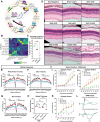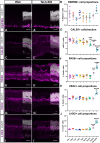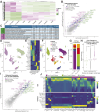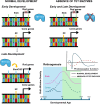Active DNA demethylation upstream of rod-photoreceptor fate determination is required for retinal development
- PMID: 40758714
- PMCID: PMC12407554
- DOI: 10.1371/journal.pbio.3003332
Active DNA demethylation upstream of rod-photoreceptor fate determination is required for retinal development
Abstract
Retinal cell fate specification from multipotent retinal progenitors is governed by dynamic changes in chromatin structure and gene expression. Methylation at cytosines in DNA (5mC) is actively regulated for proper control of gene expression and chromatin architecture. Numerous genes display active DNA demethylation across retinal development; a process that requires oxidation of 5mC to 5-hydroxymethylcytosine (5hmC) and is controlled by the ten-eleven translocation (TET) methylcytosine dioxygenase enzymes. Using an allelic series of conditional TET enzyme mutants in mice, we determine that DNA demethylation is required upstream of NRL and NR2E3 expression for the establishment of rod-photoreceptor fate. Using histological, behavioral, transcriptomic, and base-pair resolution DNA methylation analyses, we establish that inhibition of active DNA demethylation results in global changes in gene expression and methylation patterns that prevent photoreceptor precursors from adopting a rod-photoreceptor fate, instead producing a retina in which all photoreceptors specify as cones. Our results establish the TET enzymes and DNA demethylation as critical regulators of retinal development and cell fate specification, elucidating a novel mechanism required for the specification of rod-photoreceptors.
Copyright: © 2025 Hernández-Núñez et al. This is an open access article distributed under the terms of the Creative Commons Attribution License, which permits unrestricted use, distribution, and reproduction in any medium, provided the original author and source are credited.
Conflict of interest statement
The authors have declared that no competing interests exist.
Figures







Update of
-
Active DNA demethylation is upstream of rod-photoreceptor fate determination and required for retinal development.bioRxiv [Preprint]. 2025 Feb 3:2025.02.03.636318. doi: 10.1101/2025.02.03.636318. bioRxiv. 2025. Update in: PLoS Biol. 2025 Aug 4;23(8):e3003332. doi: 10.1371/journal.pbio.3003332. PMID: 39975078 Free PMC article. Updated. Preprint.
References
MeSH terms
Substances
Grants and funding
LinkOut - more resources
Full Text Sources

